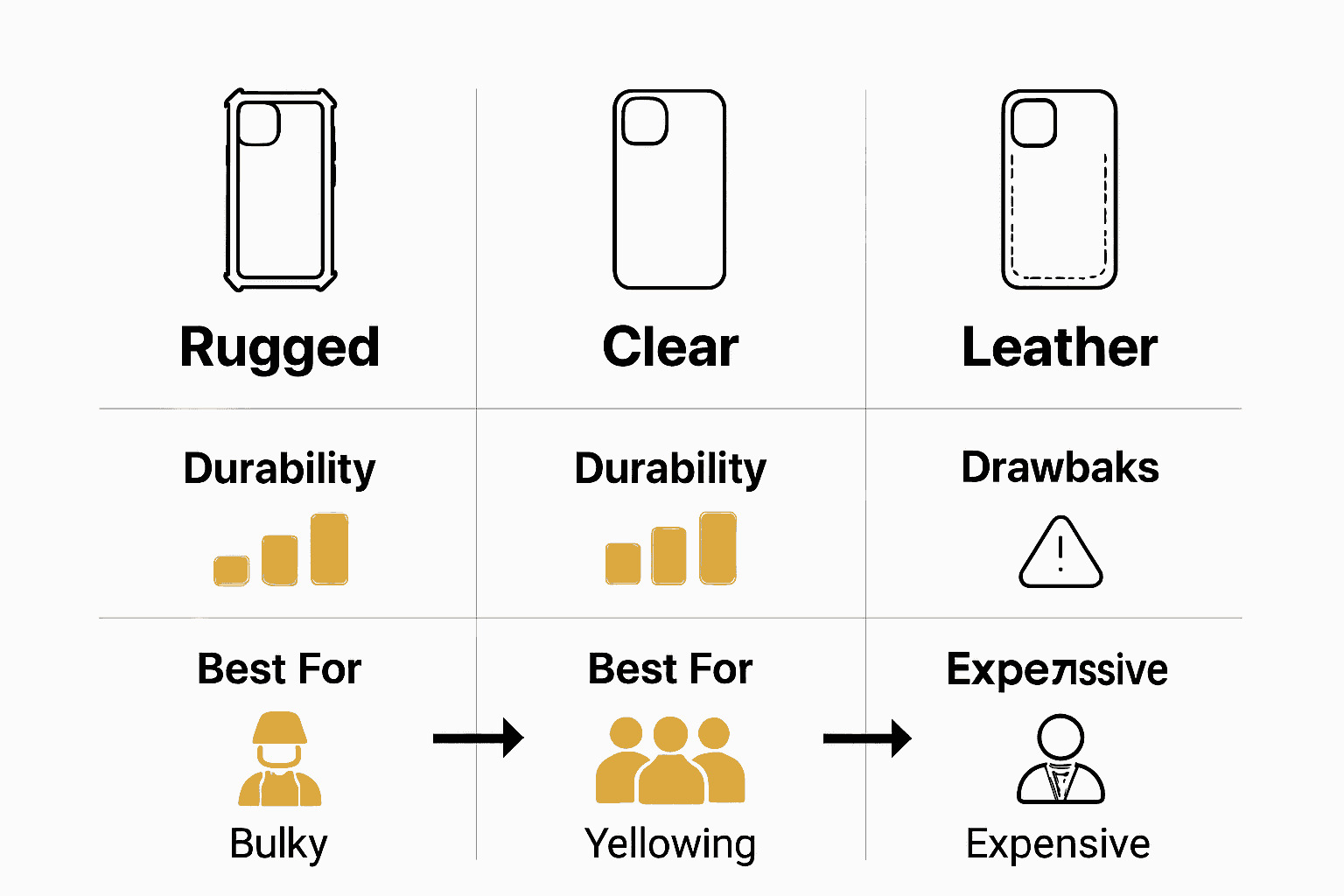
Ultimate Guide to Mobile Cases 2025: Choose & Protect
Share
Over 80 percent of smartphone users admit they have dropped their device at least once, leading to cracked screens and costly repairs. Choosing the right mobile case matters more than most people think because your protection needs vary based on daily routines, job hazards, or even busy family life. This guide breaks down the key steps you need to take so you can confidently select a case that suits your phone, your habits, and your budget.
Table of Contents
- Step 1: Assess Your Device And Protection Needs
- Step 2: Compare Case Types And Materials
- Step 3: Select Features For Lifestyle And Durability
- Step 4: Check Fit And Compatibility Before Purchase
- Step 5: Test And Maintain Your Chosen Mobile Case
Quick Summary
| Key Point | Explanation |
|---|---|
| 1. Assess protection needs based on usage | Evaluate your device’s characteristics and risks to choose the right mobile case for your lifestyle. |
| 2. Choose materials based on lifestyle | Select case materials that align with your daily activities, prioritizing durability or aesthetics as needed. |
| 3. Verify fit and compatibility | Always check compatibility with your device model to ensure seamless function and protection. |
| 4. Regularly inspect and maintain your case | Conduct monthly checks for wear and tear, and clean your case to ensure ongoing protection. |
| 5. Replace case after significant impact | Change your mobile case every 12-18 months or after any severe impact to ensure your device’s safety. |
Step 1: Assess Your Device and Protection Needs
Choosing the right mobile case requires a systematic approach to understanding your specific device protection requirements. As the National Cyber Security Centre recommends, carefully evaluating your device’s unique characteristics and potential risks is crucial for selecting optimal protection.
Start by thoroughly examining your smartphone model, screen size, and typical usage patterns. Consider factors like whether you work in rugged environments, frequently travel, or have active children who might accidentally drop your device. The UK Home Office mobile device guide suggests assessing seven key protection areas: physical durability, impact resistance, water protection, dust shielding, screen vulnerability, port coverage, and overall structural integrity.
For parents and professionals who rely heavily on their smartphones, understanding your specific risk profile matters most. A construction worker will need vastly different protection compared to an office professional. Take time to honestly evaluate how and where you use your device most frequently. Phone Case Protection: Complete Guide for UK Parents can provide additional insights into selecting the right protective accessories for your lifestyle.
Pro tip: Always measure your exact device dimensions before purchasing a case to ensure a precise fit that offers maximum protection without compromising functionality.
Step 2: Compare Case Types and Materials
Understanding the different materials and types of mobile cases can help you make an informed decision about protecting your smartphone. According to research from Industrial Engineering Letters, phone cases are crafted from a diverse range of materials including metal, wood, plastic, leather, carbon fiber, and silicone.
Each material offers unique advantages and considerations. Plastic cases tend to be lightweight and budget friendly, while leather cases provide a sophisticated aesthetic and moderate protection. Metal cases deliver maximum durability but can be heavier, and silicone options offer excellent shock absorption. The Guide to Phone Case Materials: Choose the Best Fit highlights how material selection impacts protection levels, weight, and overall device functionality.
When comparing case types, consider factors like impact resistance, scratch protection, environmental sustainability, and your personal style preferences. A construction worker might prioritize rugged materials like metal or reinforced plastics, whereas a professional might opt for sleek leather or minimalist clear cases.
 Your lifestyle and daily usage will ultimately determine the most suitable case material.
Your lifestyle and daily usage will ultimately determine the most suitable case material.

Pro tip: Always test the case material in person if possible to assess its grip, weight, and how it feels in your hand before making a final purchase.
Step 3: Select Features for Lifestyle and Durability
Choosing the right mobile case involves matching your device protection to your unique lifestyle and daily activities. According to Biareview, different materials like polycarbonate, TPU, leather, and aluminum offer varying levels of protection tailored to specific user needs and environments.
For active individuals who encounter challenging conditions, robust materials become paramount. Outdoor enthusiasts might require cases with enhanced shock absorption and water resistance, while office professionals could prioritize slim designs with minimal bulk. Consider your typical daily scenarios: do you frequently work in construction, spend time outdoors, or mainly use your phone in controlled indoor environments? The Clear Phone Case Explained: Benefits, Types, and Tips provides additional insights into selecting cases that balance protection and aesthetic preferences.
Your case should complement your lifestyle without compromising functionality. A parent might need a case with extra drop protection, whereas a photographer could prioritize a design that allows easy camera access. Durability does not mean sacrificing style consider materials that offer both robust protection and a look that reflects your personal aesthetic.
Pro tip: Always check the specific drop test ratings and protection levels of your chosen case to ensure it meets your unique environmental challenges.
Step 4: Check Fit and Compatibility Before Purchase
Ensuring your mobile case fits perfectly requires careful attention to your specific device model and precise measurements. E-Catalog highlights the critical importance of checking compatibility across various phone models, materials, and additional features before making a purchase.
Start by identifying your exact smartphone model number and verifying the precise dimensions. Different smartphone generations can have minute variations that impact case fitting. The Wallet Case Explained: Benefits, Types, and Selection recommends examining specific details like camera placement, button locations, charging port positioning, and screen edge curvature. These seemingly small details can significantly affect case performance and functionality.
Beyond basic measurements, consider how the case interacts with your additional accessories. Will it work with wireless chargers? Can you attach screen protectors? Are there cutouts for headphone jacks or additional ports? Professional photographers, frequent travelers, and tech enthusiasts should pay extra attention to these nuanced compatibility details to avoid frustrating surprises after purchase.
Pro tip: When in doubt, contact the manufacturer directly or visit their website to confirm exact compatibility with your specific device model and year of manufacture.
Step 5: Test and Maintain Your Chosen Mobile Case
Maintaining your mobile case requires proactive monitoring and regular assessment to ensure ongoing device protection. As recommended by the National Cyber Security Centre, consistent checks of your protective accessories are crucial for long-term device security and functionality.
Begin by conducting periodic inspections of your case for signs of wear, damage, or structural compromise. Look for small cracks, loose edges, or areas where the protective material might be separating. The Phone Case Durability: Essential Guide for UK Users suggests examining your case monthly for potential weaknesses that could reduce its protective capabilities. Pay special attention to corners and edges, which typically experience the most stress during daily use.
Cleaning and maintaining your mobile case is equally important. Remove the case periodically to clean both the case and your device, preventing dirt and debris accumulation that could potentially scratch your phone or compromise the case’s protective qualities. According to UK Home Office guidelines, regular maintenance helps ensure the continued effectiveness of your device’s protective measures.
Pro tip: Replace your mobile case every 12 to 18 months or immediately after any significant impact event to maintain optimal protection for your device.
Discover the Perfect Case to Match Your Protection Needs
Protecting your mobile device without compromise can feel overwhelming given the variety of cases and materials available. This guide highlights how vital it is to choose a case tailored exactly to your lifestyle, whether you need impact resistance, water protection, or a slim fit that does not interfere with functionality. You no longer need to worry about guessing which option is best because at StudioShake we understand these challenges and offer a wide selection designed to keep your phone safe and stylish.
Explore our specially curated £1 Case Collection – StudioShake to find budget-friendly options that still deliver essential protection.

Take control today by choosing a case that fits your device and daily routine perfectly. Visit StudioShake to discover durable, stylish mobile cases tailored for every need and experience the peace of mind that comes with the right protection now.
Frequently Asked Questions
How do I assess my device’s protection needs before buying a mobile case?
To assess your device’s protection needs, examine your smartphone model, screen size, and how you typically use the device. Consider where you use your phone most often and whether you’re in rugged environments or have children who might drop it. Take note of your device’s characteristics and potential risks to choose the optimal case.
What materials should I consider when choosing a mobile case?
When choosing a mobile case, consider materials like plastic, leather, metal, and silicone. Each material offers different levels of protection, weight, and aesthetics, so evaluate what fits your lifestyle best. For instance, if you work in construction, opt for durable materials like reinforced plastics or metal.
How do I ensure that a mobile case fits my specific smartphone model?
To ensure a mobile case fits your smartphone perfectly, identify your exact model number and verify its dimensions. Check for specific details like camera placement and button locations to avoid compatibility issues. Always double-check these measurements before purchasing your case.
What features should I look for in a mobile case based on my lifestyle?
Look for features in a mobile case that match your lifestyle, such as enhanced shock absorption or water resistance for outdoor activities. If you frequently use your phone in controlled environments, opt for a slim design that doesn’t add bulk. Consider your daily scenarios to select the best features for your needs.
How can I maintain my mobile case to ensure ongoing protection?
To maintain your mobile case, regularly check it for signs of wear, such as cracks or loose edges. Clean both the case and your device periodically to prevent dirt buildup and prolong protection. Conduct these maintenance checks monthly to keep your device safe and functional.
When should I consider replacing my mobile case?
Consider replacing your mobile case every 12 to 18 months, or immediately after a significant impact that may compromise its protective quality. Monitoring its condition will help you determine when replacement is necessary. Stay proactive to ensure your device continues to receive optimal protection.
